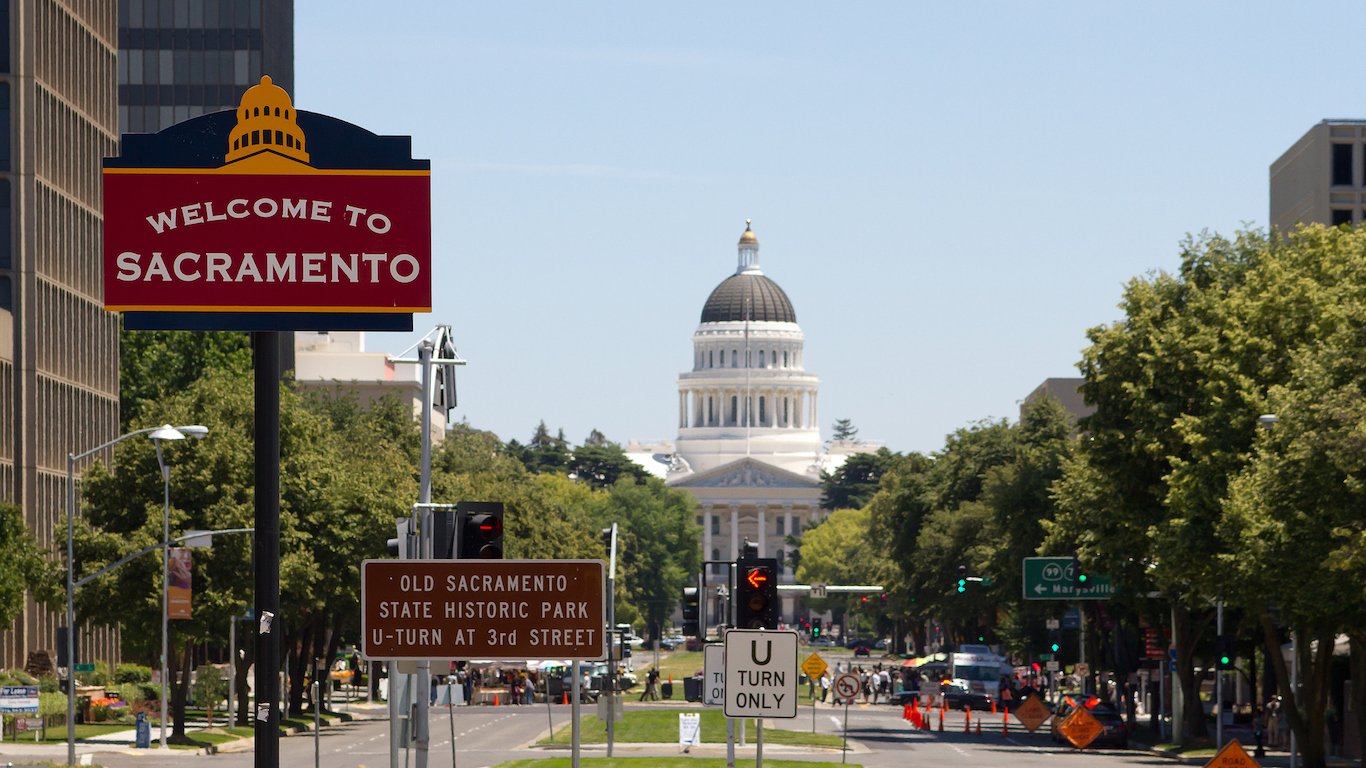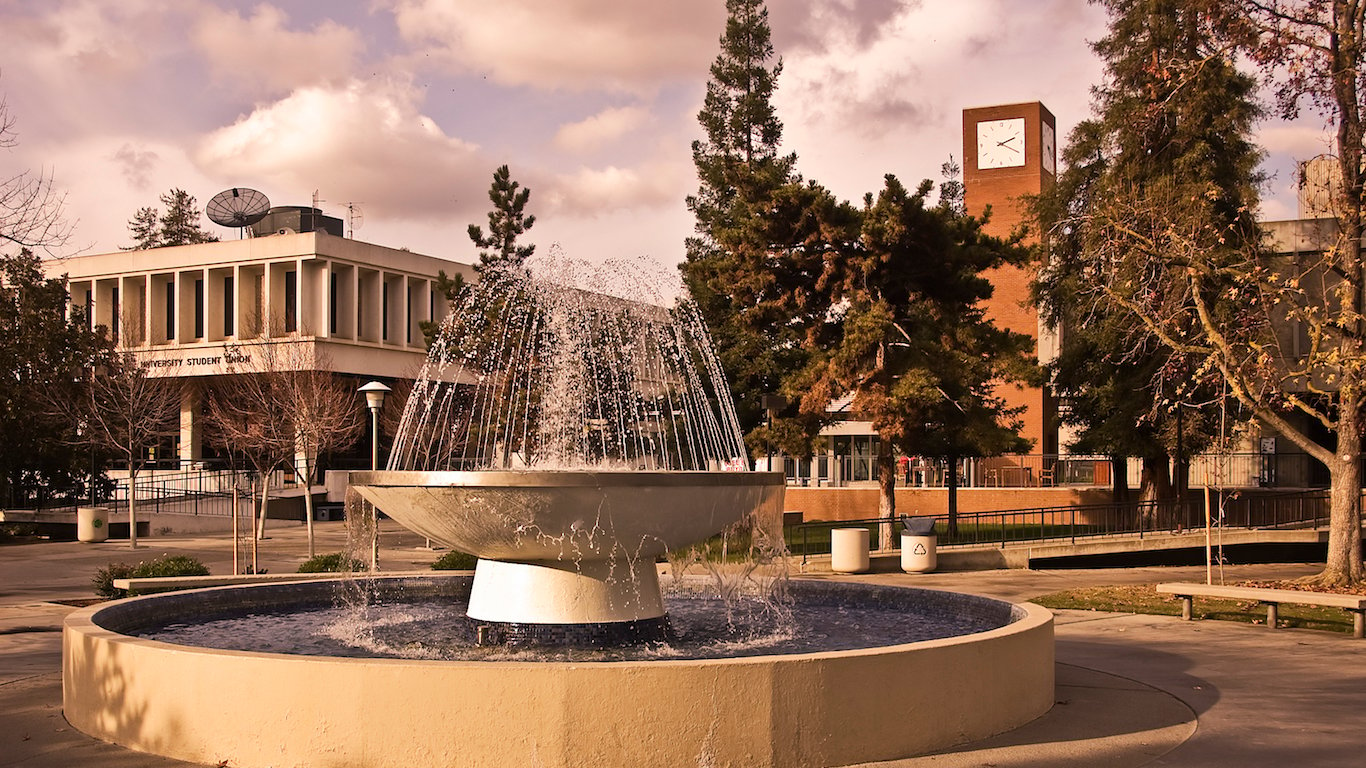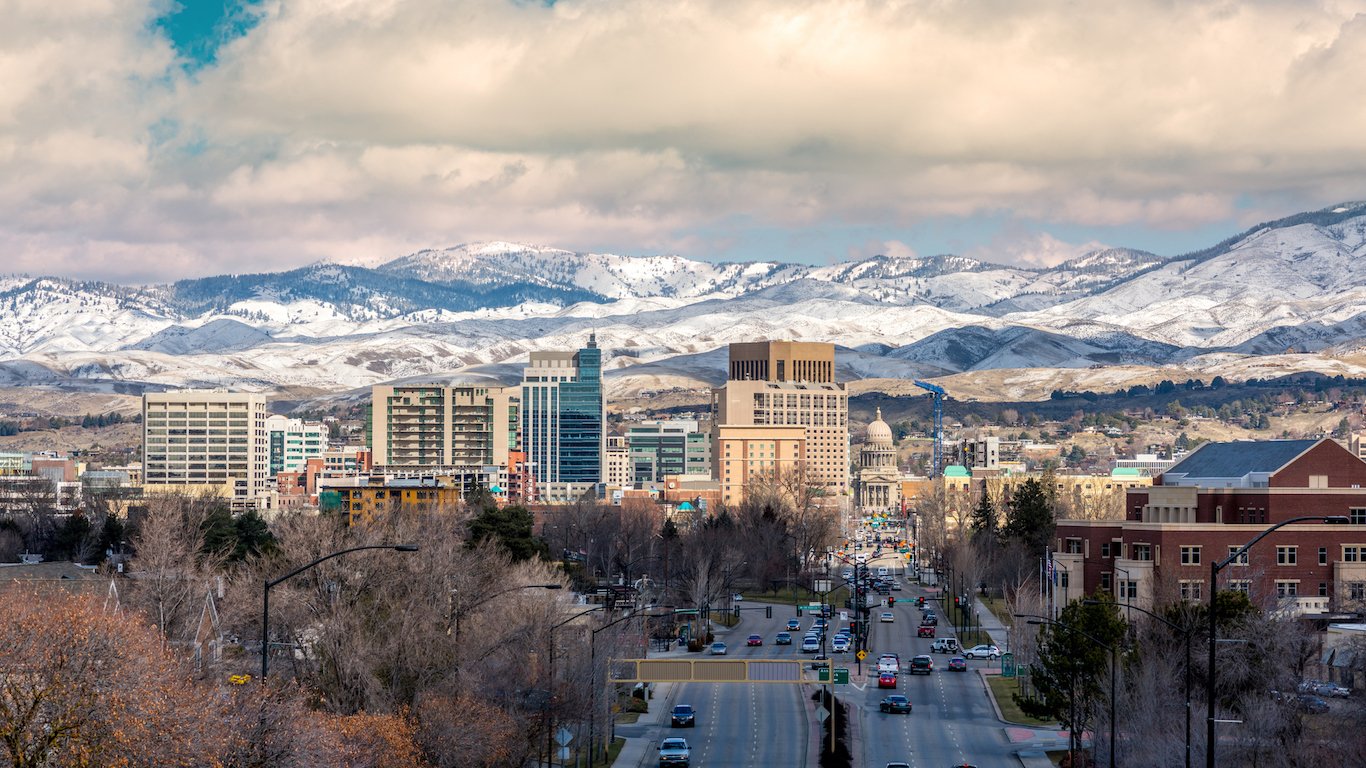Best (and Worst) Paying Cities for Women
March 27, 2017 by Evan ComenThe typical woman working full time in the United States earns just 80 cents for every dollar the typical man earns. While the gender pay gap has narrowed substantially since the Equal Pay Act was signed in 1963, in some cities the wage gap is at a level not seen on a national scale since the 1980s.
To determine the best and worst paying cities for women, 24/7 Wall St. reviewed earnings data by gender for the 100 largest U.S. metro areas.
The gender pay gap is largest in the Provo-Orem, Utah metro area, where women earn just 63.5% of men’s median earnings. The smallest wage gap is in the Durham-Chapel Hill, North Carolina metro area, where women’s median earnings are 92.8% of men’s earnings.
Click here to see the best and worst cities for women.
One factor contributing to the gender wage gap is the underrepresentation of women in the country’s highest paying industries. In an exchange with 24/7 Wall St., Julie Anderson, senior research associate at the Institute for Women’s Policy Research, explained, “The single largest contributor to the wage gap is occupational segregation, meaning women tend to go into female-dominated occupations, which have lower earnings, while men go into male-dominated occupations, which have higher earnings.”
While women in computer and mathematical occupations earn a median of $71,378 a year, compared to the $40,022 median for all jobs, just one in four workers in the profession are female. “Until more women break into those male-dominated fields,” Anderson said, “it’s going to be hard to tackle the gap.”
The pay gap is worse in professions that have historically excluded women. The typical female in the legal profession, for example, earns 53 cents for every dollar a male lawyer, judge, or clerk earns. The typical saleswoman earns 64 cents for every dollar the typical salesman earns, and women in health diagnosing and treatment professions — doctors and nurses — earn 65 cents for every dollar their male colleagues earn.
Another factor contributing to the gender pay gap is the traditional gender-based family roles in conjunction with the lack of adequate family leave and childcare policies. Given these constraints, married women often have to choose family responsibilities over time in the office. “More and more people are balancing work and family, and women tend to be the ones to shoulder unpaid caregiving,” Anderson explained. “Without policies that catch up to the new reality, women may be forced to scale back on their work or drop out altogether.”
In seven of the 10 cities with the smallest gender pay gaps, the share of women who have never been married is larger than the 30% national figure. In Provo-Orem, the metro area with the largest wage gap, more than 60% of women are currently married — the largest share of any major city.
To determine the best and worst paying cities for women, 24/7 Wall St. reviewed earnings data by gender for the 100 largest U.S. metro areas for 2015 from the U.S. Census Bureau’s American Community Survey. Educational attainment rates and the share of women who have never married and the share who are currently married also came from the ACS.
These are the best and worst paying cities for women.
The Best-Paying Cities For Women

10. Orlando-Kissimmee-Sanford, FL
> Women’s pay as a pct. of men’s: 86.9%
> Median earnings for men: $40,561
> Median earnings for women: $35,256
The typical full-time female worker in the Orlando-Kissimmee-Sanford metro area earns 86.9% of the typical male’s earnings. While this is a considerable pay difference, it is actually one of the smallest gender pay gaps in the country. One reason for the relatively small gender pay gap is the large number of high-earning female lawyers in Orlando. More than six in 10 legal positions in the city are filled by women, one of the largest shares of any major metro area. The high representation of women in the legal profession may have contributed to more equal salaries in the industry. Nationwide, female lawyers earn just 53 cents per dollar earned by their male counterparts. In Orlando, female lawyers receive 76% of the typical male pay.
[in-text-ad]

9. Sacramento–Roseville–Arden-Arcade, CA
> Women’s pay as a pct. of men’s: 87.2%
> Median earnings for men: $53,298
> Median earnings for women: $46,462
The gender wage gap is less severe in management jobs in the Sacramento metro area than it is across all metro area occupations. While nationwide the median earnings of female managers is 76% of the typical male mager’s income, in Sacramento female managers are paid 97% of the salary of their male counterparts, the second smallest gender pay gap of any major metro area for managerial occupations.
Women are relatively well-represented in fire departments throughout the Sacramento metro area. While only one in 20 American firefighters are female, nearly one in four Sacramento firefighters are women. Nationwide, the typical female firefighters earns $9,000 less than her male counterpart. Meanwhile, in the Sacramento metro area, the typical female firefighter earns roughly $17,000 more than the typical male firefighter.

8. Springfield, MA
> Women’s pay as a pct. of men’s: 87.2%
> Median earnings for men: $51,102
> Median earnings for women: $44,562
The typical full-time female worker in Springfield earns 87.2% of the earnings of the typical male worker, one of the smallest gender pay gaps nationwide. Women in Springfield tend to earn higher salaries than their counterparts nationwide in a number of high-paying professions.
While just one in 10 Springfield police officers are women, roughly half the corresponding national proportion, the typical policewoman earns $86,238 a year, over $15,000 more than the median earnings of policemen in the metro area.

7. Las Vegas-Henderson-Paradise, NV
> Women’s pay as a pct. of men’s: 87.8%
> Median earnings for men: $41,838
> Median earnings for women: $36,716
Nationwide, the food service and preparation industry has less of a gender pay gap than most other industries. In Las Vegas, 11.7% of all workers are employed in food preparation and serving occupations — the largest share of any major metro area. This may partially explain the relatively small gender pay gap in the metro area. While women are underrepresented in the profession — just 44% of such workers are female — they earn more than female foodservice workers nationwide and the gender pay gap is relatively small.
The law enforcement sector also helps close the wage gap in the Las Vegas metro area, as female law enforcement workers and supervisors earn 7.3% more than their male counterparts. In contrast, the median salary among women is 20.9% less than it is for men in law enforcement nationwide.
[in-text-ad-2]

6. Oxnard-Thousand Oaks-Ventura, CA
> Women’s pay as a pct. of men’s: 87.8%
> Median earnings for men: $53,476
> Median earnings for women: $46,942
The Oxnard-Thousand Oaks-Ventura metro area is one of the only cities in which women tend to be paid better than men in the most common profession. Roughly 13% of workers in Oxnard work in office and administrative support occupations, the largest share of any profession in the metro area. The typical female office and administrative worker in the area earns $41,663 a year, 10% more than the $37,897 median for men.
Oxnard is one of many California metro areas to benefit from the state’s 2015 Fair Pay Act. The bill strengthens the language of the state’s 1949 Equal Pay Act, prohibiting gender-based discrimination and increasing protections for workers who bring discrimination claims against their employers.

5. Miami-Fort Lauderdale-West Palm Beach, FL
> Women’s pay as a pct. of men’s: 87.8%
> Median earnings for men: $40,731
> Median earnings for women: $35,756
The typical female working full-time in the Miami-Fort Lauderdale-West Palm Beach metro area earns $35,756 a year, nearly 88% of the earnings of a typical full-time working male.
Women are relatively well represented in the city’s agriculture industry. Roughly four in 10 farming, fishing, and forestry occupations in the metro area are filled by women, one of the highest concentrations of any major metro area’s agricultural industry. The typical female agricultural worker in Miami earns $19,221 a year, just $500 less than her male counterpart — nearly the smallest such pay gap nationwide. According to a study by the Institute for Women’s Policy Research, if Florida’s gender pay gap continues to narrow at its current rate of progress, women in Florida will earn as much as men by 2038 — before any other state.
[in-text-ad]

4. Little Rock-North Little Rock-Conway, AR
> Women’s pay as a pct. of men’s: 89.0%
> Median earnings for men: $42,775
> Median earnings for women: $38,062
In the Little Rock metro area, the typical woman working full time earns 89 cents for every dollar a man earns. In comparison, the median income for women nationwide is only about 80 cents for every dollar men earn. The lower-than-average wage gap is likely partially the result of income in office and administrative support occupations, the most common field of employment in the metro area. Within this field, the typical full-time female worker earns $1.04 for every dollar the typical man earns.
Other industries in the Little Rock metro area are not nearly as favorable for women. In the legal field, the median income among women is only 38% of the median income among men in the field. The pay gap in the legal profession does not have a large effect on the overall wage gap, however, as such jobs comprise only 1.4% of all employment in the metro area.

3. Los Angeles-Long Beach-Anaheim, CA
> Women’s pay as a pct. of men’s: 89.9%
> Median earnings for men: $46,108
> Median earnings for women: $41,460
Hollywood often captures the headlines regarding the vast gender pay gap among female and male actors. Still, women working in the Los Angeles entertainment business are paid relatively well compared to other metro areas, which contributes to an overall lower gender pay gap in the metro area. Women in the arts, design, entertainment, sports, and media field earn 92% of the median earnings of men in the profession, a smaller pay gap than the 85% national figure.
While a larger share of Los Angeles residents work in arts and entertainment than in any other city, the most common profession in the metro area is administrative support. Women working in office and administrative support positions in the Los Angeles metro area earn 6% more than men in the field, while nationwide they are paid 11% less.

2. Fresno, CA
> Women’s pay as a pct. of men’s: 92.0%
> Median earnings for men: $41,766
> Median earnings for women: $38,407
A typical woman working full time in the Fresno metro area earns 92 cents for every dollar a man earns, the second smallest gender pay gap nationwide. One factor contributing to the national gender pay gap is the large share of married women who are unable to put work ahead of family responsibilities — and women in Fresno are less likely to have these responsibilities. About 37% of adult women in Fresno have never married, the third largest share of any major metropolitan area. Women in Fresno are paid more than men in a number of professions, including computer and math occupations, life, physical, and social science occupations, and education and library occupations.
[in-text-ad-2]
1. Durham-Chapel Hill, NC
> Women’s pay as a pct. of men’s: 92.8%
> Median earnings for men: $45,666
> Median earnings for women: $42,365
Overall, a woman working full time in Durham-Chapel Hill earns nearly 93 cents for every dollar a man earns, the smallest pay gap of any major U.S. metro area. The relatively small pay gap in the Durham-Chapel Hill metro may be due in part to the presence of large research institutions such as Duke University and the University of North Carolina at Chapel Hill, which can offer high-paying jobs with flexible hours. A larger share of Durham and Chapel Hill residents works in education occupations and in life, physical, and social science occupations than in any other metro area. The typical female scientists working in the metro area earns $72,321 a year, about $1,500 more than median earnings for male scientists working in the area.
The Worst-Paying Cities For Women

10. Augusta-Richmond County, GA-SC
> Women’s pay as a pct. of men’s: 74.2%
> Median earnings for men: $47,317
> Median earnings for women: $35,114
The typical woman working full time in the Augusta-Richmond County metro area earns just 74 cents for every dollar a man earns, one of the largest gender pay gaps in the country. The pay gap is most severe in the city’s legal profession. While male lawyers, judges, and other male legal workers earn a median income of $200,725 a year, the typical female in the legal profession earns just $56,362 a year. A similar gap exists in the personal care profession. While nine in 10 personal care and service workers in Augusta are female, women in the profession earn just two-thirds of what males in the field earn in a year.
[in-text-ad]

9. Salt Lake City, UT
> Women’s pay as a pct. of men’s: 73.2%
> Median earnings for men: $50,085
> Median earnings for women: $36,647
The typical full-time female worker in Salt Lake City earns just 73% of the typical male worker’s earnings in the metro area. The gender pay gap is particularly noticeable in the city’s health practitioners, installation, maintenance and repair, and firefighting professions.
While firemen in Salt Lake City enjoy the third largest salary within the profession of any city, female firefighters in the metro area earn about 45% less than male firefighters do — one of the largest pay gaps in the profession among major metropolitan areas. The Salt Lake City Fire Department’s first female battalion chief recently filed a lawsuit against the municipality claiming that certain members of the department were being overpaid and were culpable in other instances of payroll fraud.

8. Wichita, KS
> Women’s pay as a pct. of men’s: 72.7%
> Median earnings for men: $50,019
> Median earnings for women: $36,356
Women in Wichita earn just 73% of what the typical full-time working male earns, one of the largest pay gaps nationwide. The large difference in earnings between male and female sales professionals in the metro area likely contributes considerably to the overall pay gap. Close to two in three sales professionals in the metro area are women, the fourth largest such concentration in the country. Despite strong representation in the occupation, the typical saleswoman in the city earns just $26,229 a year, roughly 52% of the earnings of the typical salesman in Wichita of $50,351 a year.

7. Bakersfield, CA
> Women’s pay as a pct. of men’s: 72.5%
> Median earnings for men: $45,024
> Median earnings for women: $32,635
Bakersfield is one of the poorest metro areas in the country, with the typical full-time worker earning just $39,683 a year. Women tend to earn far less. Women in Bakersfield are less likely than women nationwide to work in business, financial, computer, and mathematical occupations, which are traditionally relatively high paying. The city’s wage gap is most evident in the legal profession, where women earn just 46 cents for every dollar the typical man working in law earns.
[in-text-ad-2]

6. Toledo, OH
> Women’s pay as a pct. of men’s: 72.0%
> Median earnings for men: $50,813
> Median earnings for women: $36,573
The typical woman working full time in Toledo earns just 72 cents for every dollar a man earns in the metro area. Women are particularly underrepresented in Toledo’s agribusiness industry. Roughly nine in 10 farming, fishing, and forestry workers in the metro area are men, one of the highest concentrations of any city’s agricultural profession. While the typical female agricultural worker in Toledo earns just $10,000 a year, men in the profession typically earn more than three times as much.

5. Ogden-Clearfield, UT
> Women’s pay as a pct. of men’s: 72.0%
> Median earnings for men: $51,319
> Median earnings for women: $36,925
Only four U.S. metro areas have a greater gender pay gap than Ogden-Clearfield, Utah. A college education can lead to higher paying jobs — and men in the Ogden metro area are far more likely to have a four-year degree than women. About a third of male adults in the area have at least a bachelor’s degree, compared to only 26.7% of female adults.
The metro area’s gender pay gap is most severe in life, physical, and social science occupations, where the typical female worker earns just 46 cents for every dollar earned by her male counterpart.
[in-text-ad]

4. Boise City, ID
> Women’s pay as a pct. of men’s: 71.6%
> Median earnings for men: $48,061
> Median earnings for women: $34,426
Women make, on average, less than 72 cents for every dollar men earn in the Boise City metro area. While the metro area’s gender wage gap is among the worst in the country, it is even more egregious in certain sectors. For example, the typical female construction worker in Boise earns $19,297 annually, less than half the $40,851 median salary among males in the same occupation. While the construction industry is dominated by men, female-dominated industries are not immune to gender pay gaps. Women in Boise City hold 82.1% of jobs in the personal care and service sector. Still, the typical female in the industry earns only 48 cents for every dollar her male counterpart earns.

3. Youngstown-Warren-Boardman, OH-PA
> Women’s pay as a pct. of men’s: 70.5%
> Median earnings for men: $45,596
> Median earnings for women: $32,141
People with a college education typically earn higher incomes than people without a degree. In the Youngstown metro area, the bachelor’s degree attainment rate is roughly equal among men and women. Despite near identical educational attainment rates, the median income of women working full time is 70.5% of the median income of area men working full time.
One partial explanation for the near nation leading pay gap may be that women in Youngstown are less likely to hold traditionally high paying jobs. Women in the metro area are less likely than men in the metro area, and than women nationwide, to work in management, architecture and engineering, law, and computer and mathematical jobs.

2. Baton Rouge, LA
> Women’s pay as a pct. of men’s: 67.0%
> Median earnings for men: $55,228
> Median earnings for women: $37,001
For most Americans, a four-year college degree translates to greater earning potential. In Baton Rouge, nearly 30% of female adults have a bachelor’s degree compared to only 26.6% of metro area male adults. Despite the significant educational attainment gap, the median income among women in Baton Rouge is only 67% of the median income for men. Even with a near nation-leading pay gap, women in the area are also more likely to work in some high-paying professions than women nationwide. Of all management workers in Baton Rouge, 47.9% are women. In comparison, women hold only 39.9% of management positions nationwide.
The gender pay gap in Baton Rouge is likely largely explained by the office and administrative support industry, the largest industry by total employment in the metro area. Within that field, women earn only 63.1% of what men in the field earn, the largest discrepancy in the field of any metro area examined.
[in-text-ad-2]

1. Provo-Orem, UT
> Women’s pay as a pct. of men’s: 63.5%
> Median earnings for men: $52,102
> Median earnings for women: $33,080
Women are severely underrepresented in many of the highest paying occupations in the Provo-Orem metro area. Women comprise fewer than 20% of all science and engineering positions in the city and just 9% of all computer and mathematical occupations. Fewer than one in three managers in Provo are women, the lowest such proportion in the country. Provo’s gender pay gap is most severe in personal care and service occupations. While the typical male in the profession earns $70,364 annually, the most of any major metro area, women in the profession earn just $18,117 annually — nearly the least of any major U.S. metro area. Overall, a woman working full time in Provo earns just 63 cents for every dollar a man earns, the largest gender pay gap of any major metro area in the country.
Sponsored: Want to Retire Early? Here’s a Great First Step
Want retirement to come a few years earlier than you’d planned? Or are you ready to retire now, but want an extra set of eyes on your finances?
Now you can speak with up to 3 financial experts in your area for FREE. By simply clicking here you can begin to match with financial professionals who can help you build your plan to retire early. And the best part? The first conversation with them is free.
Click here to match with up to 3 financial pros who would be excited to help you make financial decisions.
 24/7 Wall St.
24/7 Wall St. 24/7 Wall St.
24/7 Wall St. 24/7 Wall St.
24/7 Wall St.